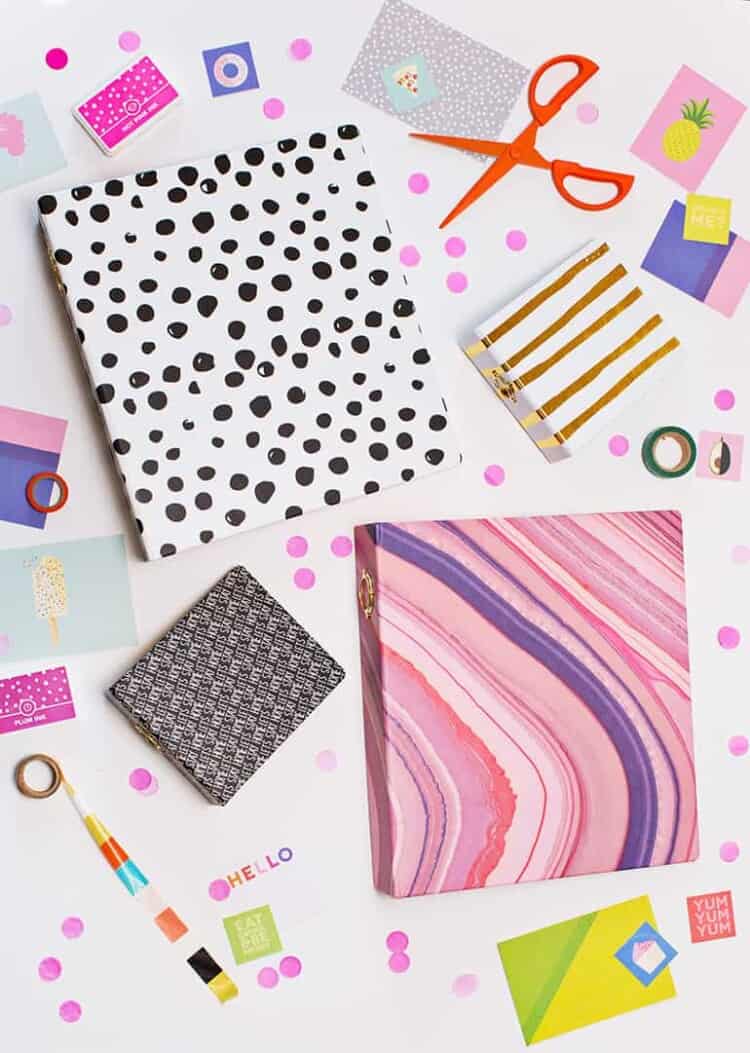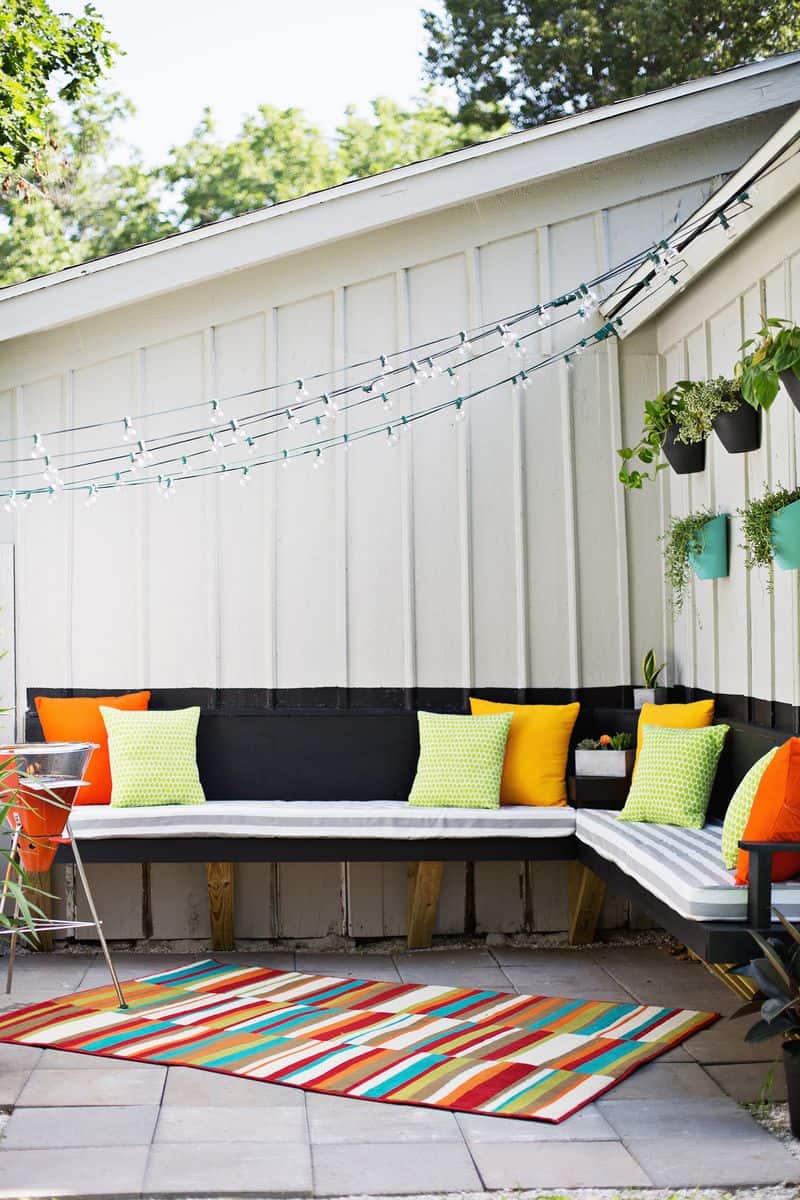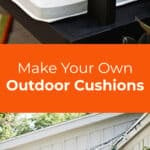Do you remember the cozy outdoor space that we created at our studio years ago?
Josh made amazing bench seating to give us a place to lounge, and we decided to add some thick outdoor cushions to make the seating area more comfy.
Having outdoor cushions makes a space look finished and one million times more comfortable. Here’s how to make your own!
Related: Make Your Own Fire Pit, Mid-Century Pergola DIY, and The Best Outdoor Furniture.
Supplies:
–canvas twill or outdoor fabric
–outdoor cushion filling
-standard sewing machine
–zipper the width of your cushion
–fabric scissors and sewing pins
–waterproofing spray
First, I measured the width and depth of each seat to see how big the cushions should be. The cushion filling I bought was 4″ tall, so I knew that number would be the height of my cushion.
To figure out the fabric dimensions for the cushion panels, take the width and depth measurements and add 1″ to both numbers to allow for a 1/2″ seam allowance all around. These measurements are for the top and bottom panels of the cushion.
To determine the side panel length, add the original measurements (the numbers before the additional inches for seam allowance) of all four sides of the large panel together.
Add 1″ onto that big number to allow for a 1/2″ seam allowance. The height of your super-long side panel is the height of the cushion filling with 1″ added for a 1/2″ seam allowance.
Take these dimensions and cut your top and bottom panel and your long side panel accordingly.
Use fabric scissors to round the edge of your fabric corners on your two larger panels.
To connect your long side panel strip and make one big continuous loop around the edge of your cushion, fold the panel in half (with the right sides facing each other), and sew 1/2″ from the edge to connect the ends.
Line up the edges of your side panel loop of fabric with the edge of the top panel (with the right sides together), and pin the edge in place.
To make the corners easier to sew, add some “V”-shaped notches around each corner.
Use your machine to sew all the way around the edges with a 1/2″ seam allowance.
Pin the bottom panel to the side panel in the same manner as the top panel, and make notches on all the corners.
Before you sew all the way around the bottom panel, you’ll want to add a zipper at one of the ends so you can insert your cushion filling.
Place the zipper face down onto the right side of the fabric at one of the ends of your bottom panel. Pin the zipper in place so that the zipper will be installed 1/2″ from the edge.
Watch the video below to learn how to install your zipper:
Use a zipper foot on your machine to sew the right side of the zipper in place.
Repeat the process of pinning and sewing the other side of the zipper so that you have a functional zipper installed.
Now you can sew all the way around the rest of the bottom panel (starting at the end of the zipper and stopping when you reach the beginning of it).
Make sure to leave your zipper open a few inches before you sew all the way around so you can get back in later! Flip your cushion cover right side out, and you’re ready to add the filling!
Use a ruler and a marker to measure the appropriate width of your cushion filling.* If you aren’t able to buy a cushion long enough that’s in one piece, you just use as many pieces as needed to fill the cushion length.
*NOTE: I would highly suggest making the width and length of the insert a little bigger than your actual cover dimensions (maybe add an inch to both). This way, the insert will fit snugly into the cover and you will have a full-looking cushion.
Now, I’ve heard that some people use jigsaws or even electric turkey carving knives to cut foam and filling, but the thing that worked the best for me was actually a plain handsaw. Weird, right?
The saw was able to do most of the cutting pretty easily, but I did use some fabric scissors to clean up the edge a bit.
Once my filling was cut to size, we folded the filling in half like a taco shell and inserted it into the cushion cover through the zipper opening. Use your waterproof spray to seal your fabric, and you’re done!
Throw in some outdoor pillows (or you can make your own) a few concrete planters, an outdoor rug and your space is ready to go!
Once you get this cushion-making technique down, you’ll be not only able to update your outdoor space, but you can also apply the principles to making cushions for lots of other seating options as well.
Happy sewing! xo. Laura
Love this post? Sign up for our newsletter for more ideas!

Get creative ideas for recipes, crafts, decor, and more in your inbox!
 Get the How-To
Get the How-To
Supplies
- canvas twill or outdoor fabric
- outdoor cushion filling
- zipper the width of your cushion
Equipment
- standard sewing machine
- fabric scissors
- sewing pins
Instructions
- First, I measured the width and depth of each seat to see how big the cushions should be. The cushion filling I bought was 4″ tall, so I knew that number would be the height of my cushion.
- To figure out the fabric dimensions for the cushion panels, take the width and depth measurements and add 1″ to both numbers to allow for a 1/2″ seam allowance all around. These measurements are for the top and bottom panels of the cushion. To determine the side panel length, add the original measurements (the numbers before the additional inches for seam allowance) of all four sides of the large panel together. Add 1″ onto that big number to allow for a 1/2″ seam allowance. The height of your super-long side panel is the height of the cushion filling with 1″ added for a 1/2″ seam allowance.
- Take these dimensions and cut your top and bottom panel and your long side panel accordingly.
- Use fabric scissors to round the edge of your fabric corners on your two larger panels. To connect your long side panel strip and make one big continuous loop around the edge of your cushion, fold the panel in half (with the right sides facing each other), and sew 1/2″ from the edge to connect the ends. Line up the edges of your side panel loop of fabric with the edge of the top panel (with the right sides together), and pin the edge in place.
- To make the corners easier to sew, add some “V”-shaped notches around each corner.
- Use your machine to sew all the way around the edges with a 1/2″ seam allowance.
- Pin the bottom panel to the side panel in the same manner as the top panel, and make notches on all the corners.
- Before you sew all the way around the bottom panel, you’ll want to add a zipper at one of the ends so you can insert your cushion filling. Place the zipper face down onto the right side of the fabric at one of the ends of your bottom panel. Pin the zipper in place so that the zipper will be installed 1/2″ from the edge.
- Use a zipper foot on your machine to sew the right side of the zipper in place.
- Repeat the process of pinning and sewing the other side of the zipper so that you have a functional zipper installed. Now you can sew all the way around the rest of the bottom panel (starting at the end of the zipper and stopping when you reach the beginning of it). Make sure to leave your zipper open a few inches before you sew all the way around so you can get back in later! Flip your cushion cover right side out, and you’re ready to add the filling!
- Use a ruler and a marker to measure the appropriate width of your cushion filling.* If you aren’t able to buy a cushion long enough that’s in one piece, you just use as many pieces as needed to fill the cushion length. I would highly suggest making the width and length of the insert a little bigger than your actual cover dimensions (maybe add an inch to both). This way the insert will fit snugly into the cover and you will have a full-looking cushion.
- Now, I’ve heard that some people use jigsaws or even electric turkey carving knives to cut foam and filling, but the thing that worked the best for me was actually a plain old handsaw. Weird, right? The saw was able to do most of the cutting pretty easily, but I did use some fabric scissors to clean up the edge a bit. Once my filling was cut to size, we folded the filling in half like a taco shell and inserted it into the cushion cover through the zipper opening. Use your waterproof spray to seal your fabric, and you’re done!


Nice blog, Laura. It has clearly explained how to make cushion covers and add the cushion filling. Once you know how to make a cushion you can easily upgrade your outdoor space. You can add custom seat pillows to make your outdoor space more comfortable. The instructions are given nicely.
My patio officially got a cozy makeover thanks to your tutorial on how to make Garden Cushion! The fabric you used is a good one and the design is very homey. I think I only did my sewing patterns on this one for just 5 minutes (haha just kidding). Anyway, every sip of tea and book session feels like a mini vacation now. Who needs a resort when you’ve got this level of comfort at home?
I used this pattern to make patio chair cushions. 22″ wide cushions not readily available for purchase in a 3 or 4 inch depth. even with clipping the corners, I found that it was quite frustrating to attach the long side panel piece at the corners. it did not feel like a beginner task. i do love the end result, however.
Another good option is to use www.foamorder.com – they make beautiful custom cushions for a great price and ship them directly to your doorstep!
How do you determine how much fabric to buy?
I would make a little drawing of each panel you’ll need for your shape (top, bottom, and sides with seam allowance) and then see what length and width your chosen fabric comes in and kind of map out on paper how many yard you need to fit everything. You can also ask for some help at the fabric counter if you have your drawing with you!
Laura
Love this. Cushions are so expensive to buy ready made. Thank you.
I am making 21” cushions for my patio. Does this mean I need 85” for my side panel? This is a lot of fabric per cushion and I need to make 6. I need the measurement to be exact. They will be 4” in height also. Please help ASAP, for I am in the middle of cutting my fabric now.
I’m a little curious about how you actually measure the fabric for the panels. I understand measuring the length and width of the foam insert and adding 1/2’ on each side for seams, but then at the end you suggest making the cushion cover smaller than that so that the insert fits tightly. To make it an inch smaller in each direction, wouldn’t you then just cut to the exact width and length of the panels and take the 1/2”seam allowance on each side to make the panels an inch shorter in each direction?
Sorry, having a tough time understanding the exact question, but I think I was suggesting to make the top and bottom largest panels a little smaller than the exact width/length of the foam so that it’s a snug fit when you stuff it in…
Laura
Just found this before embarking on a similar project, I’m a bit of a beginner and I’m struggling to make sure I order the right type of fabric, I want it to be nice to sit on so not plastic coated. Could you help? 🙂 I’d usually go into a shop and look but it is not possible at the moment :p
Look in outdoor fabric sections of fabric stores for more weather proof material! They should have a section that’s suitable for outdoors 🙂
Laura
This is awesome! I’m making couch cushions for a pallet couch I built with my sister. What thickness of foam did you use? We’re going with 4 inches but I’m not sure if thats good! Also, what kind of zipper did you use? Thanks!
I would do at least 3″ tall cushions and a basic zipper should work, maybe a plastic one if it will be exposed to a lot of wet weather…
Laura
Love this! We are making our own deck chairs and finding 25″ x 25″ cushions isn’t easy and the ones I did find were expensive and not what I wanted. Hopefully I can find the zipper size I need. Looking forward to making them. TFS!
I love it! Where did you get the rug?
Looks great! Where did you get the foam?
Thank you!
Melissa
Check your local craft/fabric store like JoAnns or Michaels!
Laura
My cushions are old but in good shape. The most at risk is the foam. We live in a very dry climate and the lining has basically disintegrated. What fabric can I use to cover the foam that will withstand the heat/dry climate, dry quickly and retain the life of the foam?
You should be able to find a fabric that has a plastic coating on one side (or is heavily waterproofed) and that would help keep rain off of the foam! Check fabric stores in the outdoor section
Laura
Great information! This is really a nice idea and I am curious to be a part if it.
Many many thanks for this step by step guide. I used to couch basketball to my neighboring kids in the afternoon. So, their parents come to my backyard where the basketball court is located. I was searching for a budget solution to make a comfortable bench for those guests and I’ve found your tips which is very easy to follow. Moreover, your images makes the process 100% clear. Thanks again!
Another alternative for a kids’s bed room is bunk beds or a raised bed on stilts.
Rather the mattress rests directly on top of two adjacent bases making the
entire bed system much more compact and neat.
Thanks for the tutorial!
Is the foam you linked to pretty firm? I would be using these cushions on top of pallets and I’m afraid if the foam is too soft it’ll compress too much and you’ll be able to feel the boards.
That green foam is a little more firm but if there’s a lot of space between the boards you may want to put another board down first
Laura
What a lovely seating area you have created! ? The colours of the pillows similar to what I have made. And that brings me to my question, where did you get the amazing carpet? I have been looking for one with all these colours and have yet to find one. I realize this posting is a couple of yrs old, but a carpet like that could till be out there for me, lol!
Keep up the good work girls!
This post is awesome. It gives me an idea on how to make a diy cushion. Moreover pacific outdoor fabrics is at good choice such as the color which is a good combination. It complements well which makes the place comfortable to stay with.